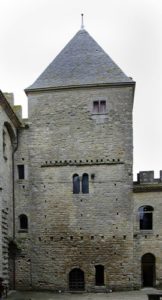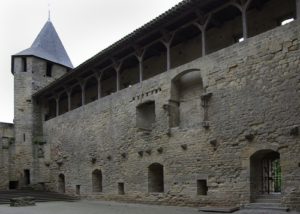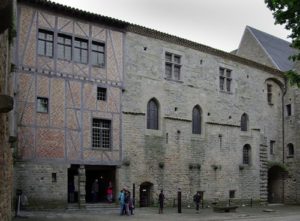Chateau Comtal is an impressive site seen from Rue Cros Mayrevieille. Many people stop to take a photograph but don’t bother to go inside. This is a shame as it is a well worth while visit, especially the Musée Lapidaire.
Backing onto the city walls, this dates from the 12thC when the square keep, chapel (now demolished) and two towers were built in a U shape around a courtyard. The castle was extended in the 13thC with the arrival of the Royal Garrison. A dry moat and semi-circular bastion topped with battlements and a fortified gate was added to improve its defence. The outer wall with crenelations and more towers were built. The bailey between the castle and barbican could be used to assemble troops in preparation for a siege. The gatehouse of the barbican could not be closed off on the inside. If taken it wouldn’t provide any protection or shelter for the attackers from cross bow fire from the castle.
The outer walls of the castle on the south side have reconstructed. Small slits allowed arrows to be fired through the bottom of the walkway and stones to be dropped. wooden walkways round the top. Below are arrow slits. Hoarding beams slide into holes in the masonry left during construction. This was very common before in 12/13thC before stone machicolations were built.
The ticket office is in the outer barbican, A stone bridge crosses the moat to the main gateway guarded by two towers with pointed roofs. These were originally flat. The pointed roofs are a result of the 19thC Violett-le-Duc restorations. Inside is the main courtyard with to large plane trees in the centre. The keep is opposite the gateway. To the right is a long two storey 12thC stone building. At right angles to the left is a three storey 13thC stone and half timber frame building with a diagonal brick infill. Beyond this is the smaller midi courtyard which has a well in a corner. The kitchens were along the outside wall.
The earliest building on the site from the early 12thC, is in the north east corner of the site. It is built against the Roman ramparts, and is only accessible from them. One of the original Roman towers can still be seen on the north rampart wall and is recognisable by its semi-circular outside wall and flat wall facing the courtyard. The chapel in front of this building was built on a Roman site and remains of mosaics were found when it was demolished in the 18thC. All that remains is a raised stone dais in the courtyard. Later in the 12thC, the buildings were crenelated and the keep, intended as a watch tower, was built. The castle was annexed by the French King in 1226 after the Albigensian Crusade and the defences reinforced on the town side when the bailey and barbican were built, mainly to protect the castle from rebellion by the local population who were loyal to the Trencavel family. The keep was increased in height and the castle became a feudal residence. The vaulted chamber in the keep was decorated by a vast mural with an animal frieze and a scene depicting a battle between Franks and Saracens.
The keep was in use until the 19thC when Napoleon IV army had a presence here.
We were handed a short guide to the castle and allowed to wander at will. Steps lead up to the ceremonial hall which has a short video presentation. From here there is access to the walkways through the walls and the ramparts. Exit is by the shop which is disappointing and expensive.
The keep and 12thC range to the right of it now house Musée lapidaire. This was a fascinating Aladin’s cave of secular and religious stonework. There are some beautiful carved religious statues including a 14thC Virgin holding the Christ Child with a dove, representing the Holy Spirit. There are some amazing 15thC polychrome alabaster reliefs with representations of the passion, entombment and resurrection of Christ. There are carved corbels and Gothic arches. There is a 6thC Meovingian sarcophagus and medieval gravestones. There is a massive white marble 12thC fountain.
The 15thC calvary comes from a cemetery near Carcassone. The 12 apostles are carved round the top of the pillar. On the front is a small scene of the crucifixion with Mary and St John on either side of Christ with Mary Magdalene at his feet. Above is an angel. At the base is a full size figure of Christ being presented to the people by (a now headless) Pontius Pilate On the far side are the executioners with grimacing faces and wearing medieval dress. On the reverse is small scene of the crowning of the Virgin. Mary holding the Christ Child is flanked St Michael and a bishop. Below are full size polychrome figures of the Virgin and the Angel Gabriel.
The beautifully painted 12thC frieze in pastel shades of blue, red, yellow and greens, runs round the top of the walls in the main hall of the keep. The Franks are wearing conical helmets and have elongated shields. The Saracans have turbans and round shields. Along the top is a narrow border with paintings of animals. Below there is a narrow border with what look like upside down hearts. The painting had been covered beneath several coats of whitewash and was only rediscovered in 1926.
The château does get busy and walkways through the walls are narrow. Disabled access into the buildings is poor. Having said that, it is worth visiting. The Musée Lapidaire is fascinating.










